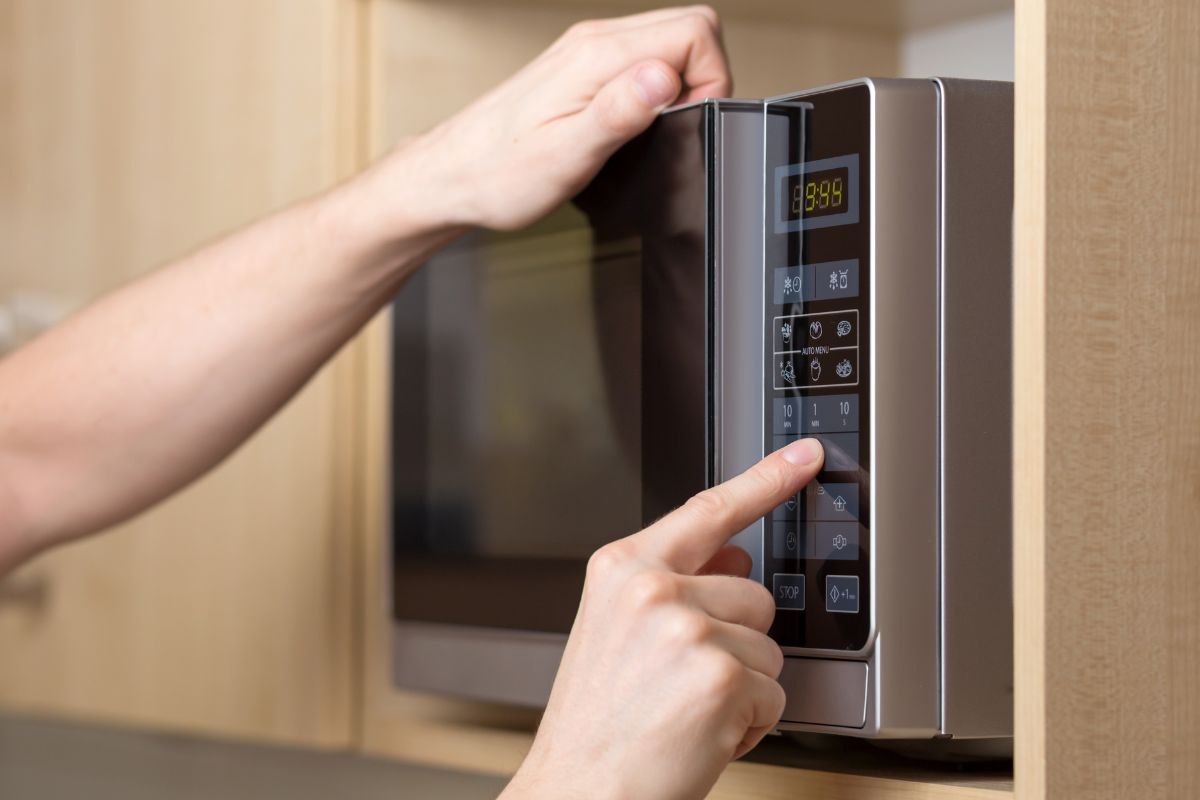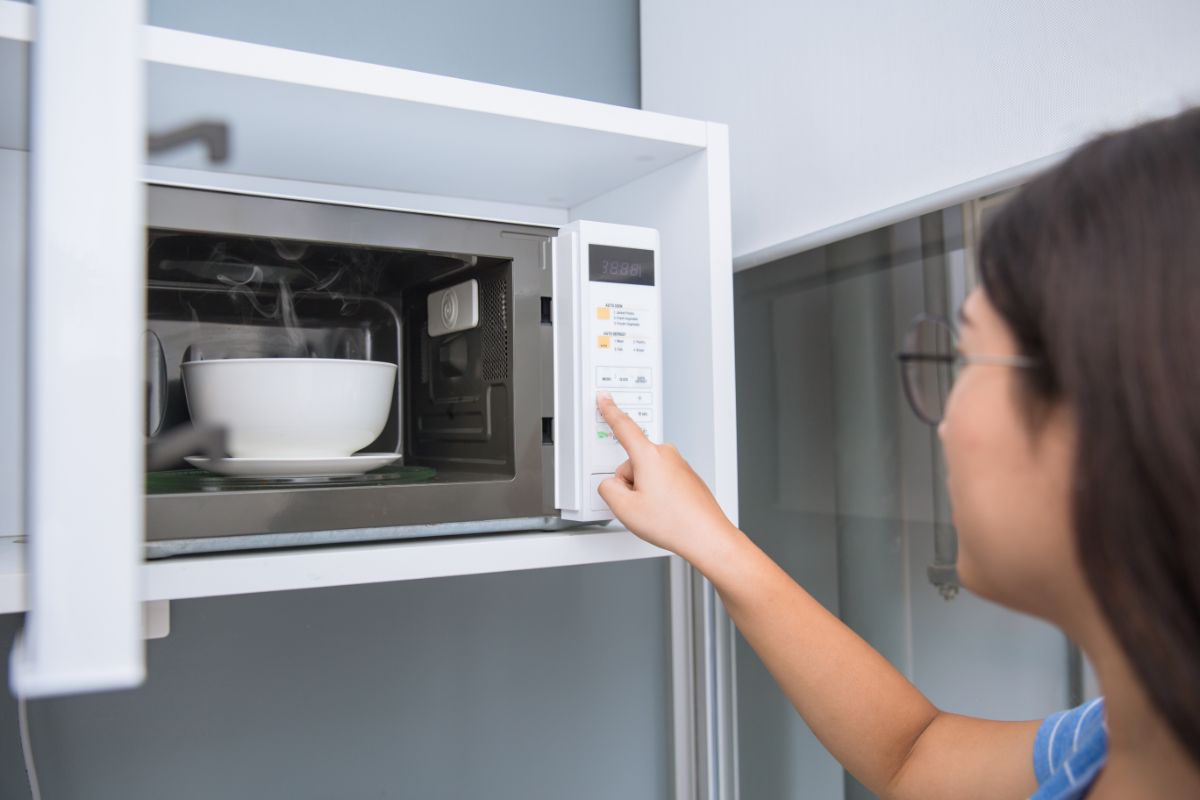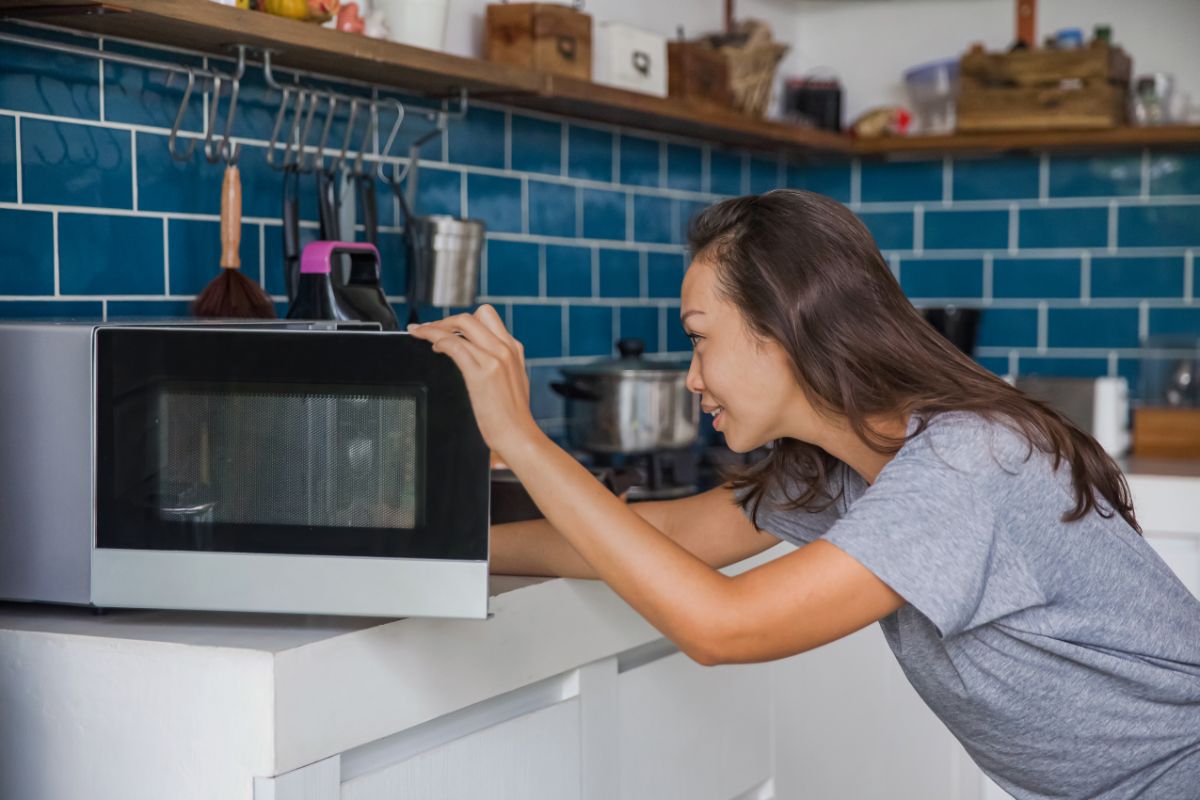If you have ever reheated food, then you may or may not be aware that you can only use certain containers. You might even see labels on the side of cartons of food that state ‘microwave reheat only’, but what does this mean?

Well, the first thing you should know about reheating is that it is not the same as operating your microwave at full power. Reheating will usually happen over a longer period of time and will be much lower in heat. You should think of it more as ‘warming’ rather than ‘cooking’.
But what containers are appropriate to reheat your food with and what containers aren’t? How can you find out this information? What happens if you put a non-microwavable container in a microwave by mistake? Will your plastic container melt? Well, we’re going to explain to you exactly what microwave-safe reheat means.
How Can I Use The Microwave Reheat Setting?
As we have stated above, you should know that the microwave reheat setting should only be used for reheating rather than cooking food. If you are reheating food it will often occur at a lower temperature and for a shorter period of time.
The other reason for this is so that the container does not melt, as it would if you cooked something inside at full power. You should avoid using a microwave at full power with a container, as this could damage it beyond repair.
If you are microwaving a meal, then most of the time you should check the icons on the side of the packaging. With some food it will be very obvious, but with other food not so much. So always make sure that you check the packet before you buy.
If My Product Says ‘Microwave Safe’, What Does That Mean?
If you want to put your containers in the microwave, you might be worried about plastic warping or getting damaged. You might also have a legitimate worry about chemicals transposing from your container to the food itself.
However, if a container says that it is microwave safe, then none of the above things will happen, you can be sure. These products have been tried, tested and designed to give you a meal that is safe to eat once you have put it in the microwave.
But what if your container does not have this symbol on the side? Well, this does not necessarily mean that it is dangerous, but to be on the safe side we would recommend that you don’t put it in the microwave, as it could lead to making your food toxic.
Some people might be slightly nervous about microwaving a plastic container, as they might be worried about contamination. However, there are plenty of other options that you can use to microwave your food.
It might be helpful to provide you with a brief list of containers and non-edible items that are safe to put in the microwave.
What Items Can I Put In A Microwave?

There are many types of containers that you can put in a microwave. Here is a list of just some of the things that you can put in a microwave:
1. Glassware – This is highly heat resistant and very easy to clean. This is great for microwaving pasta, noodles and pies.
2. Ceramics – This is another very durable material, often used for cooking at high intensities and warming up food once again.
3. BPA-free – this is the kind of container that does not contain the chemical Bisphenol A, which can often be toxic to people.
4. Porcelain – This is very much like ceramic in that it can withstand intense heat, although some porcelain might not be suitable for super intense heat.
5. China – this is very similar to both porcelain and ceramics in that it can withstand a lot of heat. However, not all China is suitable for microwaving and you might want to check the label beforehand.
6. Plastic – there are 5 different labels for plastic containers, all of which indicate that they are safe to be put in the microwave.
You should make sure that none of the above vessels contain metal and make sure that under no circumstances you should put metal in the microwave. If you ever put metal in the microwave, you will notice that it produces electric shocks.
What Items Should I Not Put In My Microwave?
There are plenty of items that you should not put in your microwave, one of the main ones being metal. No type of metal should be put in a microwave, whether it is stainless steel, aluminum, or copper. This will cause electric shocks and might even make the microwave malfunction.
In some instances when you are putting metal in the microwave, you’ll notice there are electrical sparks, which could even lead to an explosion.
If you have ever accidentally put a fork in the microwave, you can see how dangerous that it will get. Sometimes metal fragments will shoot out of the microwave door, so we would recommend that you take our word for it when we say that you should not try this out.
There are many non-microwavable plastics that you should also avoid putting in the microwave. You should avoid microwaving plastic like Styrofoam and plastic cups, as they will melt and produce a lot of smoke. You will also run the risk of polluting your food with some of these types of plastics.
Is There A Test To See If Something Is Microwavable?
The best method of checking if something is microwavable or not is by checking the underside of the packaging. You’ll be able to check the microwavability of your packaging by looking at the number next to the PP or triangle symbol.
You’ll need to make sure that you look out for the number 5, as this will indicate how microwavable it is.
As we discussed earlier, microwave-safe plastic can only be heated within a certain heat spectrum. There is a distinct difference between cooking and reheating, and the latter is done at a much lower temperature, so make sure you do not cook a microwave-safe meal.
The great thing about microwave-safe containers is that you can reuse them over and over again. They are great for storing food that is hot and cold. Most microwavable food can take boiling hot food straight from the microwave or oven, although you will still have to be mindful of warping.
How To Test A Microwavable Container

Even if they have a label, you can always double-check to see if your containers will be able to resist being microwaved. Here is a quick test that you can do to see if your containers can be microwaved or not:
1. Fill With Water
Take your microwavable container and fill it with 1 cup of water. You might need to adjust how much water you put in your container according to the size of the container.
2. Put Your Container In The Microwave
Insert your container into the microwave without the lid on so that it doesn’t explode.
3. Turn Up The Heat
Set the dial on your microwave to the highest setting for around 1 minute.
4. Remove
Once the container has finished microwaving, open the door and reach inside to touch the sides. If the container is still cool to the touch and the water inside is hot, then this means that you can microwave your container. If the container is hot, then this means it is not microwavable.
Here are some other tips that you can follow to make sure that your container is safe to microwave:
1. Check your containers – make sure that you check your microwavable containers to see if there is a microwavable symbol at the bottom.
2. Look for the wavy lines – the way you can tell if an item can be microwaved is if they have 3 wavy lines somewhere on the packet.
3. PP symbol – look for the symbol that has PP somewhere on the packet, this will indicate that it is microwave-proof.
4. CPET symbol – this will appear on items that you can microwave safely.
5. APET symbol – this will appear on items that it is not safe to microwave at all. These are safe for packaging and they can be recycled, but you cannot reheat or cook them.
6. Polystyrene – you should never put this substance in the microwave, as it will often cause a transfer of harmful chemicals from your container to your food. This type of plastic can keep your food warm, but it cannot be exposed to intense heat.
7. Paper – Products like paper plates and paper cups cannot be placed in the microwave. This is simply because they contain harmful chemicals and additives that can leak out once they are heated.
Using Microwave Reheat Items Correctly
It is important to bear in mind that you shouldn’t heat up your items too intensely for any length of time, as they will begin to lose their integrity.
With increased warping will come distortions in the shape of your plastic container, which will ultimately affect how it stores food and whether or not the lid closes tightly.
If you are eating your food frozen, you should make sure that you are going through certain protocols first before you place the food in the microwave. Here are a few things that you should bear in mind:
1. Defrost First
You should always defrost your food before you reheat it in the microwave. You can do this by either putting it on the defrost setting in the microwave or leaving it in the refrigerator overnight.
2. Stir When Reheating
You should make sure that you stir your food regularly as you are reheating it. This will stop it from getting cold spots which can make the food inedible and increase the risk of bacteria.
What Should I Know About Microwave-Safe Plastic?

Plastic is made from chemical byproducts of heating up fossil fuels, which is what gives them the unique properties they have. However, finding out the difference between microwave-safe plastic and microwave-unsafe plastic is tricky.
You always have to make sure that the label is clearly showing whether or not you can microwave one of these items. Products that can be microwaved are usually made with reinforced plastic that is coated with chemicals to prevent them from melting under low heat.
Here is a brief rundown of the different gradients of plastic and how they fare when you put them in the microwave:
- Types 1, 2 and 4 – these are the plastics that are safe to put in the microwave on low heat. They do not melt unless you expose them to very intense heat.
- Type 5 – This is also a microwavable option, as it is very resilient to any form of heat.
- Type 3, 6, and 7 – these are not safe to microwave and will melt no matter how much or how little heat you put them under.
Is It Good To Reheat Food In Plastics?
The World Health Organization recommends that you don’t reheat food in plastic as it will encourage the transfer of chemicals from the container to the food. This is because BPAs have been shown to disrupt the endocrine system.
It has been shown that some of these substances are linked to illnesses and diseases as diverse as infertility, thyroid disease, leukemia, and prostate, thyroid, and uterine cancers. But you don’t have to bin your plastic container collection just yet. Bear a few of these things in mind:
1. FDA Regulations
The FDA regulates all plastics that are used in combination with foods. They will ensure that any chemicals that are used in the production of these plastic containers are within safe boundaries for human beings.
2. Not All Plastics Are Bad
There are some plastics that can be subjected to milder temperatures for shorter periods of time. Generally, type 1, 2, 4 and 5 plastics are safe to heat and use with food. Type 3, 6 and 7 plastics are not safe.
Basically, eating from plastic containers will not harm you in the short term, but they have been shown to contain some harmful chemicals that could be transferred to food.
How Can You Avoid Contaminating Your Food With Plastic?
If you adhere to these rules, then you can generally avoid any contamination in your foods:
1. Avoid BPA and phthalate plastics.
2. When you are heating in the microwave, make sure that you use glass, porcelain or microwaveable-safe plastics.
3. Do not cover your food with plastic, instead, use paper towels to cover your dishes.
4. Do not store your food in disposable plastic, use metal, glass, or ceramic containers instead.
5. The older your plastic is, the more degraded it will be. Make sure that you throw out your old plastic regularly.
6. Do not reuse old water bottles or takeaway containers.
7. Do not place hot food or liquid in disposable plastics.
8. Do not defrost your food in plastic containers.
9. Make sure that you pay attention to the markings on your plastic containers. Make sure that you know what the numbers signify.
Frequently Asked Questions
Just because your packaging is safe to microwave, that does not mean that you can put it in the oven.
As we have stated before, microwavable plastic should only be heated on a very low setting.
Ovens have much higher heat settings than microwaves, so you should avoid putting your plastic in the microwave at all costs.
Conclusion
We hope that this guide to microwaveable plastics has helped you in your usage of them. Make sure that you always check for the proper markings and that you can recycle your plastic.
You should be aware that only some plastics can be microwaved and that some will result in the transfer of harmful chemicals.
- How To Reheat A Cheesesteak - November 5, 2023
- What Are Three Must Have Kitchen Knives? - September 22, 2023
- How To Protect Edges Of Pie Crust - June 15, 2023








